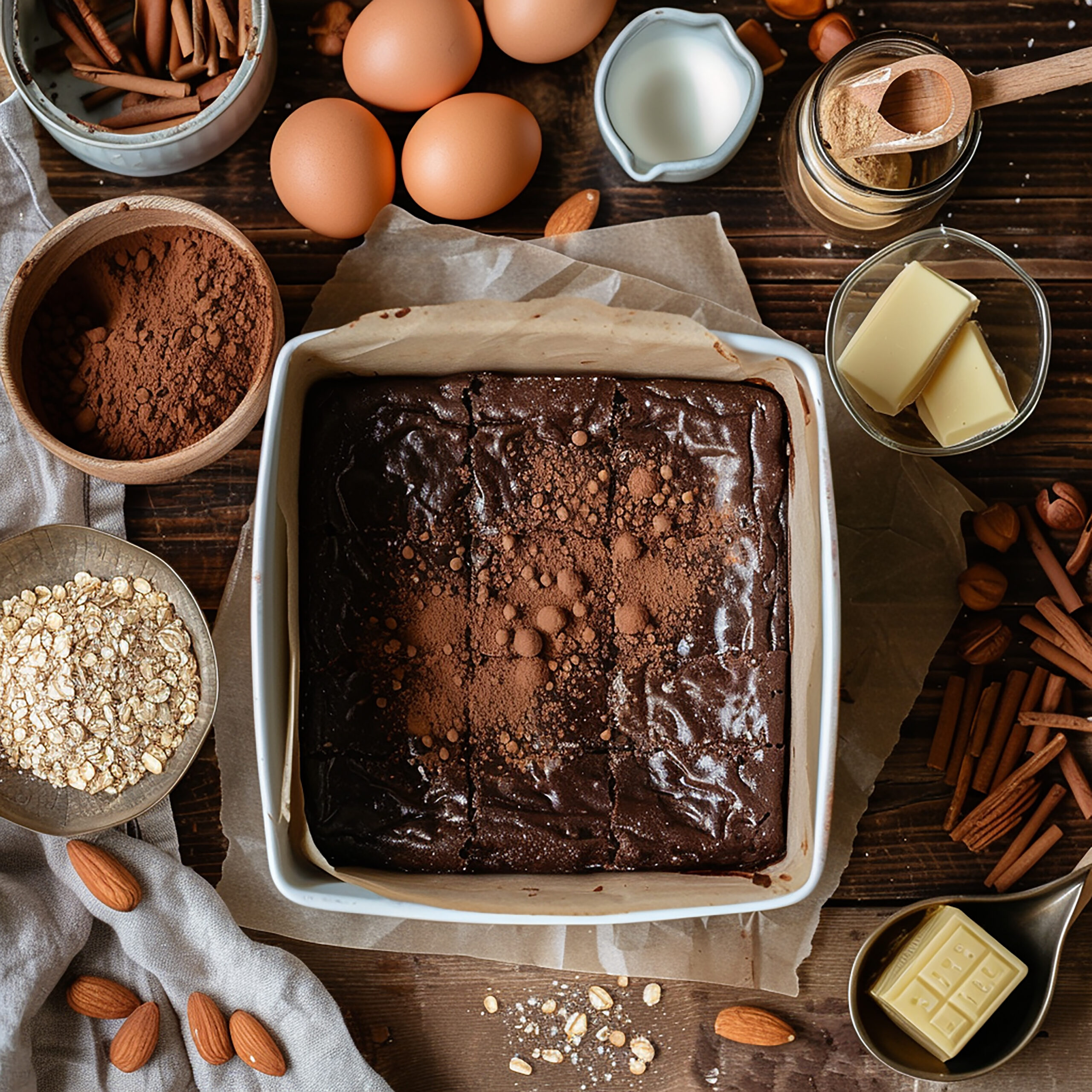Introduction
If you’re a chocolate lover, there’s nothing quite like the rich, dense, and indulgent taste of a brownie cake. This dessert combines the best elements of a fudgy brownie with the soft, moist texture of a cake, creating a treat that’s both comforting and luxurious. Whether you’re looking to impress guests at a dinner party, need a special dessert for a birthday, or simply want to indulge in some self-care with a decadent chocolate fix, this brownie cake recipe is the answer.
In this blog post, we’ll guide you through the steps to create the perfect brownie cake, offer tips for success, and even explore some variations that you can try. We’ll also delve into the origins of the brownie, discuss the best ingredients to use, and share some pairing suggestions that will elevate your dessert experience to the next level.
History and Origins of Brownie Cake
The brownie, as we know it today, is a relatively modern invention. It first appeared in American cookbooks in the early 20th century. There are several stories about its origin, but the most popular one suggests that the brownie was created by accident when a baker forgot to add baking powder to a chocolate cake recipe, resulting in a denser, chewier product.
Brownie cakes, on the other hand, are a more recent adaptation, combining the richness of a brownie with the soft crumb of a cake. This fusion allows for a versatile dessert that can be dressed up or down, depending on the occasion.
The Essential Ingredients
Chocolate: The Heart of the Brownie Cake
Chocolate is the star ingredient in any brownie cake. To achieve that deep, intense flavor, it’s essential to use high-quality chocolate. Whether you prefer dark chocolate, semisweet, or even milk chocolate, the key is to choose a chocolate with at least 60-70% cocoa content. This will ensure that your brownie cake has that signature richness without being overly sweet.
Tip: You can experiment with different types of chocolate to suit your taste. For a more intense flavor, use dark chocolate with a higher cocoa content. For a sweeter, creamier cake, try using a combination of dark and milk chocolate.
Butter: Richness and Moisture
Butter is another crucial ingredient that adds richness and moisture to the brownie cake. It helps create that melt-in-your-mouth texture that makes brownies so irresistible. Be sure to use unsalted butter so you can control the amount of salt in your recipe.
Tip: For an extra depth of flavor, try browning the butter before adding it to the batter. This will give your brownie cake a subtle nutty taste that’s absolutely delicious.
Sugar: Sweetness and Structure
Sugar not only sweetens the brownie cake but also contributes to its structure. Granulated sugar helps to aerate the batter when creamed with butter, giving the cake its lightness. Brown sugar, on the other hand, adds moisture and a slight caramel flavor, which complements the chocolate beautifully.
Tip: If you want a chewier brownie cake, use more brown sugar. For a crisper top, stick with granulated sugar.
Eggs: Binding and Richness
Eggs play a vital role in binding the ingredients together and adding richness to the cake. They also help to create a smooth, glossy batter, which translates to a tender, fudgy texture in the finished product.
Tip: For a denser cake, use one less egg. If you prefer a lighter, more cake-like texture, add an extra egg.
Flour: The Foundation
Flour provides the structure for the brownie cake. All-purpose flour works perfectly in this recipe, giving the cake enough body without making it too heavy. It’s important not to overmix the batter once the flour is added, as this can lead to a tough, dense cake.
Tip: For a gluten-free version, substitute the all-purpose flour with a gluten-free flour blend. Almond flour can also be used for a nutty flavor and denser texture.
Cocoa Powder: Intensifying the Chocolate Flavor
Adding cocoa powder to the batter boosts the chocolate flavor and gives the cake its deep, dark color. Use unsweetened cocoa powder to maintain control over the sweetness of the cake.
Tip: For an even richer flavor, use Dutch-processed cocoa powder, which has been treated to reduce acidity and has a smoother, more mellow taste.
Additional Ingredients: Customizing Your Brownie Cake
- Vanilla Extract: Enhances the overall flavor and complements the chocolate.
- Salt: Balances the sweetness and intensifies the chocolate flavor.
- Baking Powder or Soda: While optional, a small amount can be added if you prefer a slightly lighter texture.
Tip: Feel free to add mix-ins like chocolate chips, nuts, or even a swirl of caramel or peanut butter for added flavor and texture.
Step-by-Step Brownie Cake Recipe
Ingredients
- 200g (7 oz) high-quality dark chocolate (60-70% cocoa)
- 200g (7 oz) unsalted butter
- 200g (1 cup) granulated sugar
- 100g (1/2 cup) brown sugar
- 4 large eggs
- 1 tsp vanilla extract
- 125g (1 cup) all-purpose flour
- 30g (1/4 cup) unsweetened cocoa powder
- 1/2 tsp salt
- Optional: 1/2 tsp baking powder
Instructions
- Preheat Your Oven: Preheat your oven to 180°C (350°F). Grease and line a 9-inch round cake pan with parchment paper, ensuring the paper extends up the sides for easy removal.
- Melt the Chocolate and Butter: In a heatproof bowl, combine the chopped dark chocolate and butter. Melt them together over a pot of simmering water (double boiler method), stirring occasionally until smooth. Remove from heat and let it cool slightly.
- Mix the Sugars: In a large mixing bowl, whisk together the granulated sugar and brown sugar. This step helps break down any lumps in the brown sugar and ensures an even distribution.
- Combine the Wet Ingredients: Add the eggs, one at a time, to the sugar mixture, whisking well after each addition. Stir in the vanilla extract. The mixture should be smooth and glossy.
- Incorporate the Chocolate Mixture: Slowly pour the melted chocolate and butter mixture into the egg mixture, whisking continuously to combine. Make sure the chocolate mixture isn’t too hot, as it could cook the eggs.
- Add the Dry Ingredients: Sift the flour, cocoa powder, and salt (and baking powder if using) into the wet ingredients. Gently fold the dry ingredients into the wet ingredients using a spatula. Be careful not to overmix; stop as soon as the flour is incorporated.
- Pour and Bake: Pour the batter into the prepared cake pan, smoothing the top with a spatula. Bake in the preheated oven for 25-30 minutes, or until a toothpick inserted into the center comes out with a few moist crumbs attached.
- Cool and Serve: Allow the brownie cake to cool in the pan for about 10 minutes before transferring it to a wire rack to cool completely. Once cooled, slice and serve.
Serving Suggestions
Brownie cake is delicious on its own, but there are several ways to elevate your dessert experience:
- Whipped Cream: A dollop of freshly whipped cream balances the richness of the brownie cake.
- Ice Cream: Serve with a scoop of vanilla or coffee ice cream for a classic pairing.
- Fresh Berries: Add a burst of freshness with raspberries, strawberries, or blueberries.
- Ganache or Fudge Sauce: Drizzle warm chocolate ganache or fudge sauce over the top for an extra indulgent treat.
Tip: If you’re serving this cake at a dinner party, consider pairing it with a dessert wine, like a rich port or a sweet red wine, to complement the chocolate flavors.
Tips for Success
Achieving the Perfect Texture
The key to a perfect brownie cake lies in the balance between a fudgy brownie and a soft cake. Here are a few tips to help you achieve the ideal texture:
- Don’t Overmix: Overmixing the batter can lead to a tough, dense cake. Fold in the dry ingredients just until combined.
- Watch the Baking Time: Brownie cake is best when it’s slightly underbaked, so it remains moist and fudgy. Start checking for doneness around the 25-minute mark.
- Use Room Temperature Ingredients: Cold eggs and butter can cause the batter to curdle, so make sure all your ingredients are at room temperature before you begin.
Storing Your Brownie Cake
Brownie cake can be stored at room temperature for up to 3 days in an airtight container. If you want to keep it longer, wrap it tightly in plastic wrap and store it in the refrigerator for up to a week. You can also freeze individual slices for up to 3 months; just thaw them at room temperature before serving.
Variations to Try
Nutty Brownie Cake
For added texture and flavor, try adding nuts to your brownie cake batter. Walnuts, pecans, or hazelnuts work particularly well. Simply fold in a cup of chopped nuts before pouring the batter into the pan.
Marbled Brownie Cake
Create a stunning visual effect by swirling in a layer of cream cheese or peanut butter into the batter. To do this, prepare the brownie cake batter as directed, then drop dollops of softened cream cheese or peanut butter on top. Use a knife to swirl it through the batter before baking.
Salted Caramel Brownie Cake
For a sweet and salty twist, drizzle salted caramel sauce over the top of the brownie cake once it’s baked and slightly cooled. The combination of rich chocolate and salty caramel is sure to be a hit.
Espresso Brownie Cake
Enhance the chocolate flavor with a hint of espresso. Simply add a teaspoon of instant espresso powder to the dry ingredients, or substitute some of the water in the recipe with brewed coffee.
Pairing Brownie Cake with Beverages
Coffee and Espresso
The deep, rich flavor of brownie cake pairs perfectly with a cup of coffee or espresso. The bitterness of the coffee complements the sweetness of the cake, making for a well-rounded dessert experience.
Milk
For a classic pairing, serve your brownie cake with a cold glass of milk. The creaminess of the milk helps to balance the intense chocolate flavor, making each bite even more enjoyable.
Red Wine
For a more sophisticated pairing, consider serving brownie cake with a glass of red wine. A fruity red like Zinfandel or a robust Cabernet Sauvignon can stand up to the richness of the cake while adding its own complex flavors to the mix.
The Nutritional Breakdown
While brownie cake is undoubtedly a treat, it’s also helpful to know what you’re indulging in. Here’s a rough nutritional breakdown per serving (assuming the cake is divided into 12 slices):
- Calories: 350-400 kcal
- Fat: 20-25g
- Carbohydrates: 40-45g
- Protein: 4-5g
- Sugar: 25-30g
Tip: If you’re looking to reduce the calorie count, consider using a sugar substitute or reducing the amount of chocolate used. You can also substitute some of the butter with applesauce for a lower-fat version.
Conclusion
The brownie cake is more than just a dessert; it’s a celebration of chocolate in its most indulgent form. Whether you’re enjoying it on a quiet evening at home or serving it to guests, this brownie cake recipe is sure to impress. With its rich, fudgy texture and deep chocolate flavor, it’s a dessert that satisfies every time.


